Generic framework for industrial 4.0 applications based on internet of things
The Internet of Things (IoTs) is a network of interconnected devices, transportations, home appliances, and other devices. They are functionally embedded in electronics, software, sensors, actuators, and connectivity that allows them to connect and exchange information. On the basis of the
IoT concept, implementations are gradually being proposed in a range of areas, ranging from smart
house, smart office and smart agriculture. In this research paper, a generic framework for smart
monitoring applications based on the IoTs network is proposed. In this framework, low-powered
sensor nodes are based on the micro:bit platform, providing a multiple footprints for different sensor connections. The wireless capability on micro:bit provides a complete solution to deploy the
system in such places that wire is impractical to draw. The data is wirelessly gathered by a basestation node that is powered by Android Things operating system provided by Google. This operating system is based on the Android platform for smart devices and Internet of Things products. The
approach to this framework indicates a low cost and minimum setup and especially amenable for
applications control. To support many applications with minimum modifications, the framework is
designed for easy expansion by supporting popular serial connection ports, including the Universal Asynchronous Receiver/Transmitter and Serial Peripheral Interface. With these connections, on
one line data bus, several sensors can be added to match the different application requirements.
In this paper, our platform is validated for an automatic water monitoring in aquaculture based on
the temperature, pH and dissolved oxygen sensory data. Through our framework, the data is uploaded to a cloud for remote monitoring and providing alarms for users whenever the data is out
of a predefined safe domain
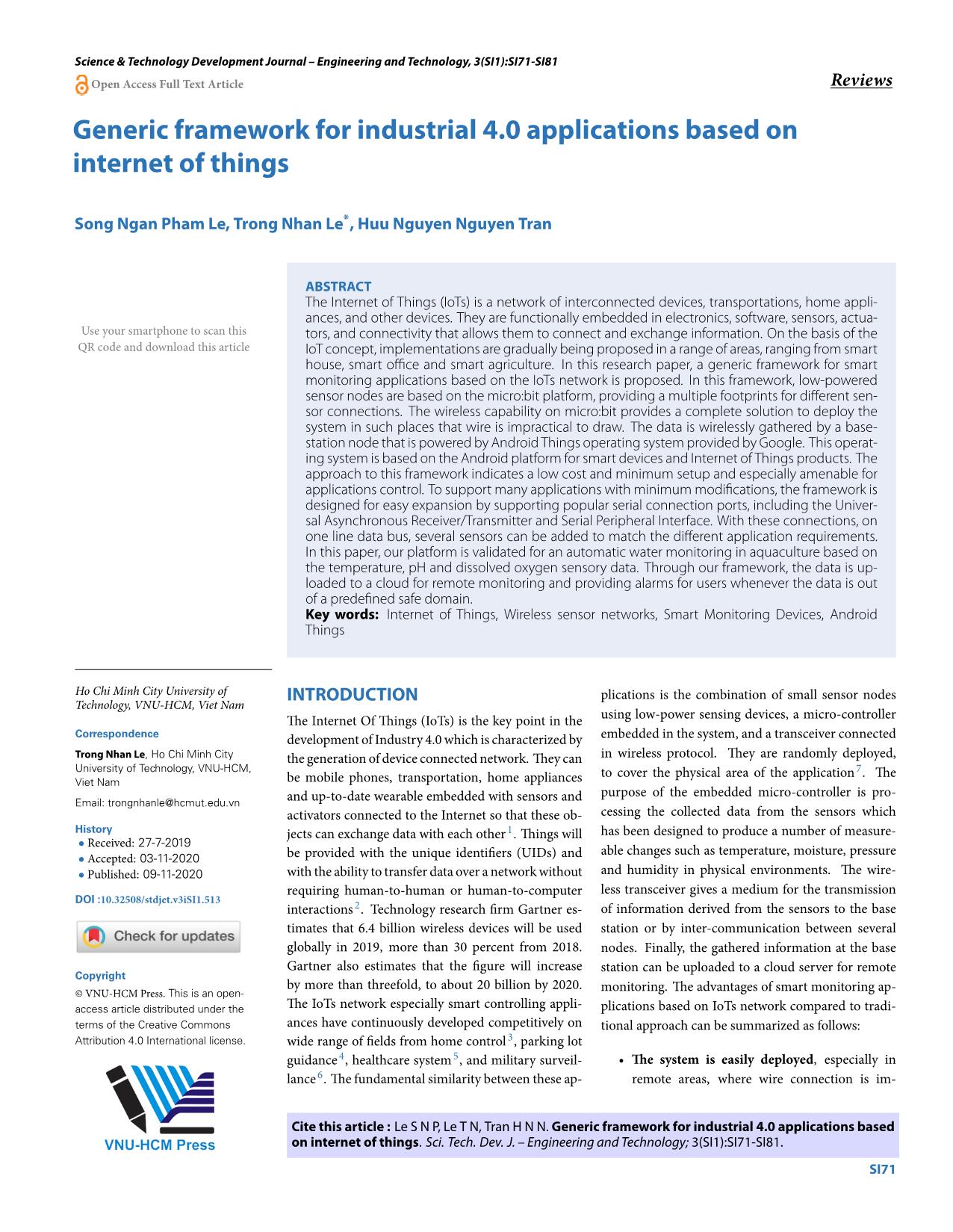
Trang 1
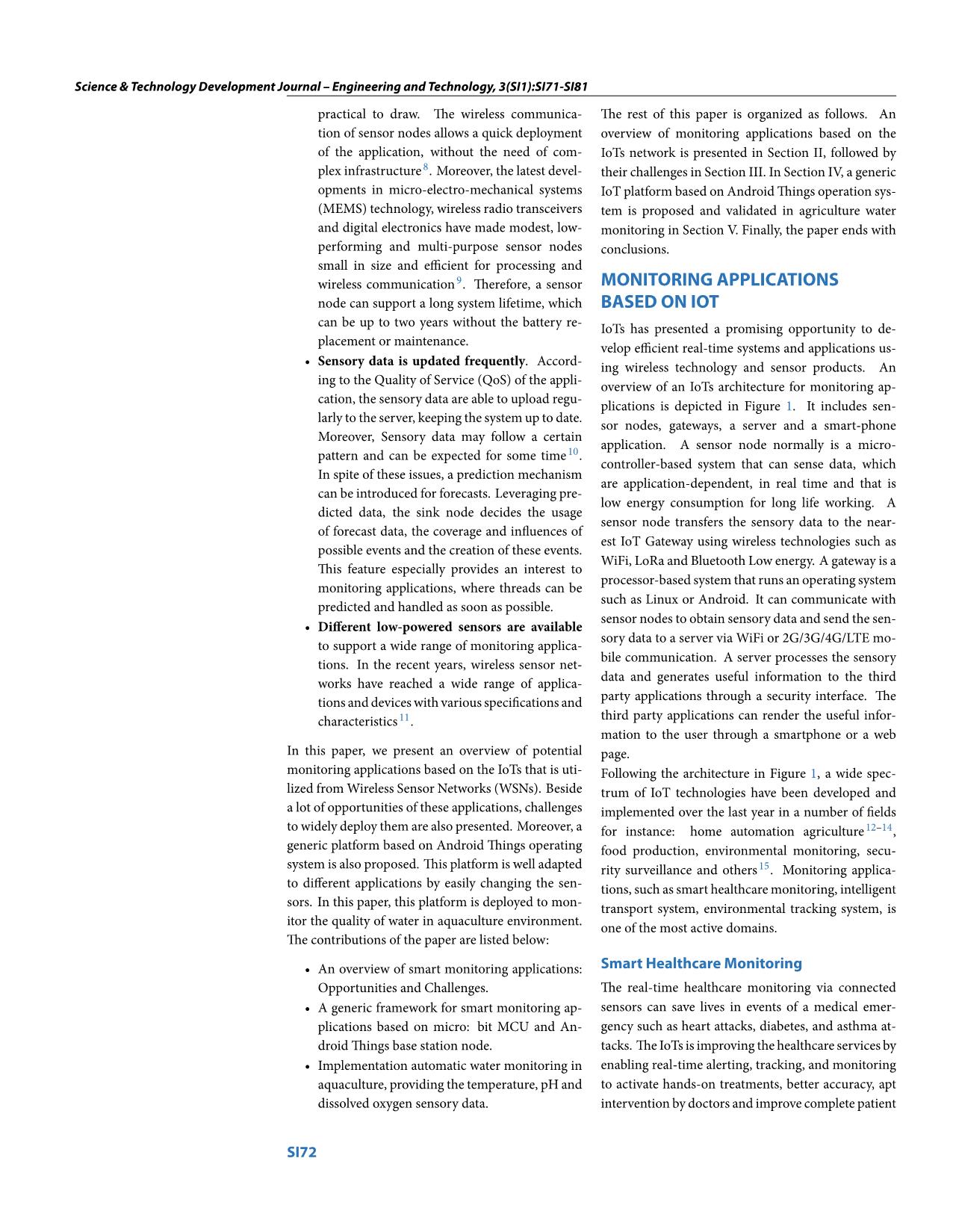
Trang 2
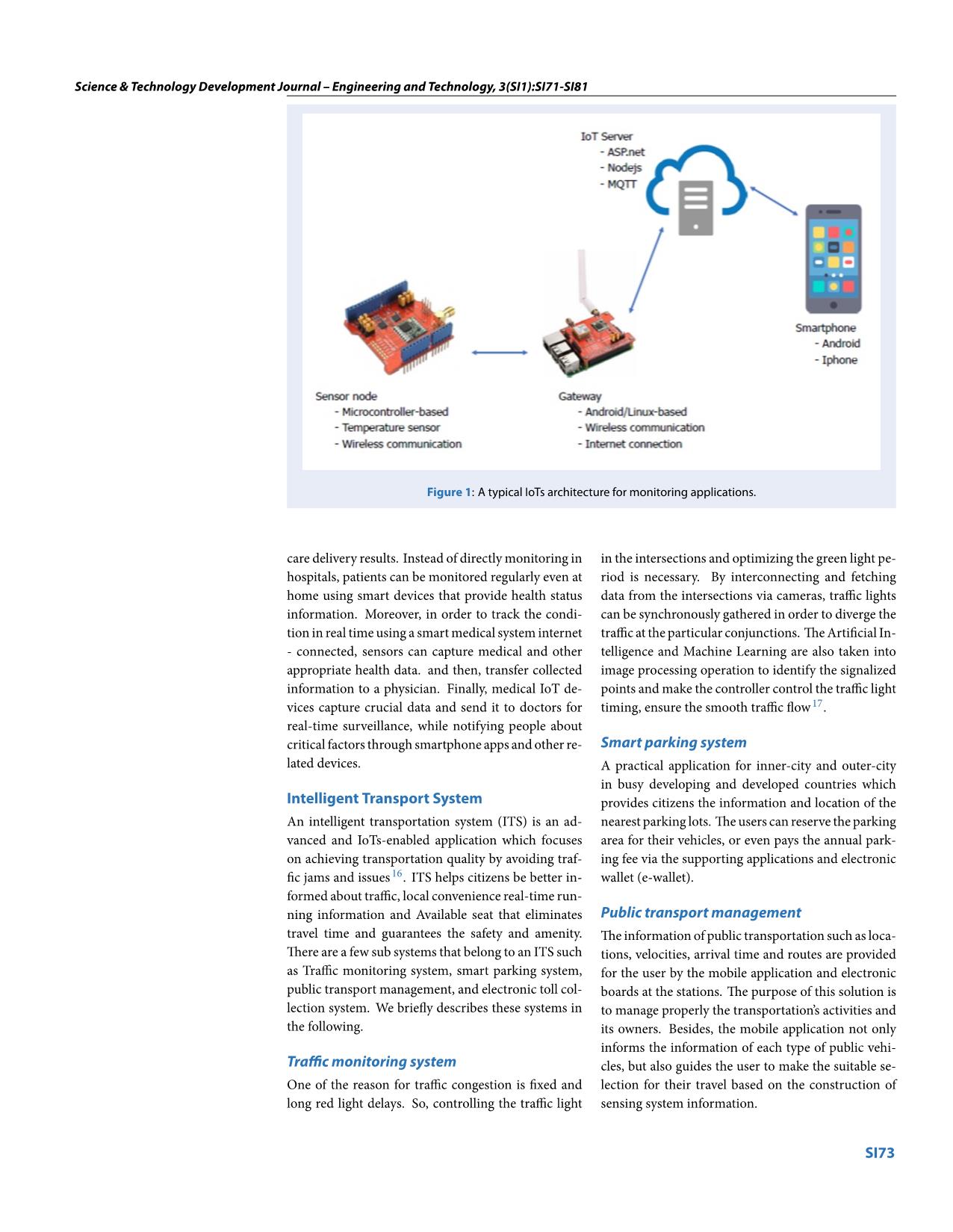
Trang 3
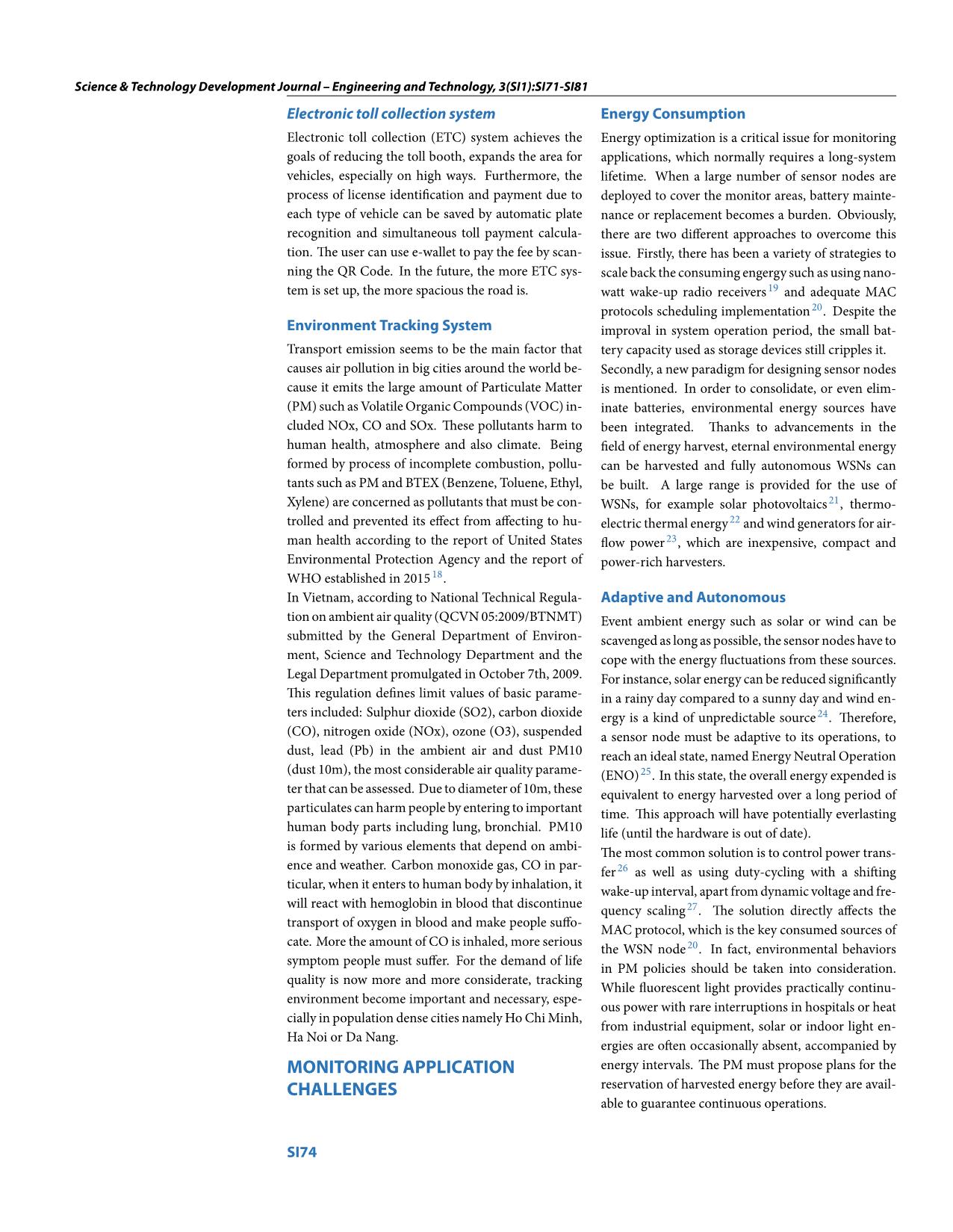
Trang 4
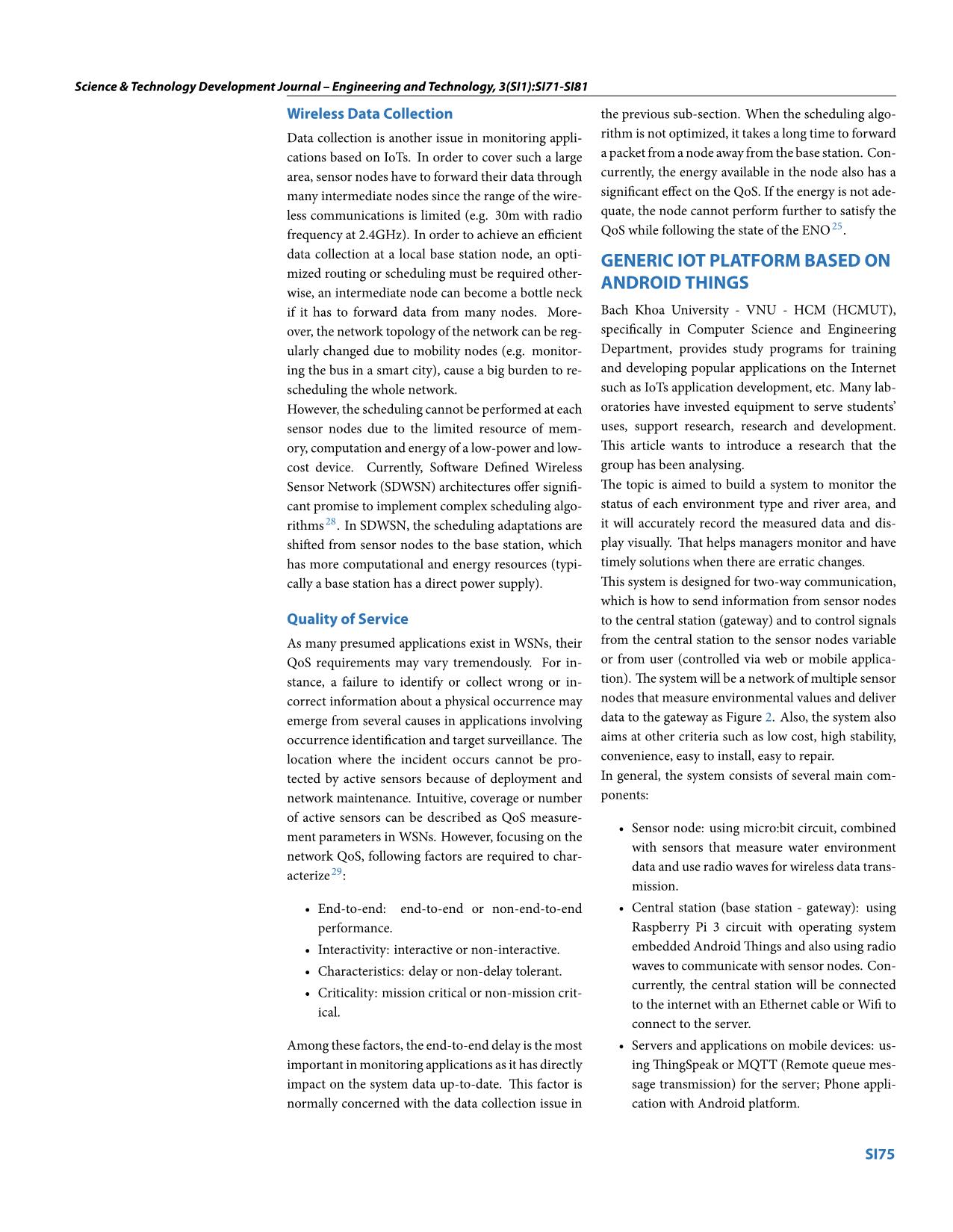
Trang 5
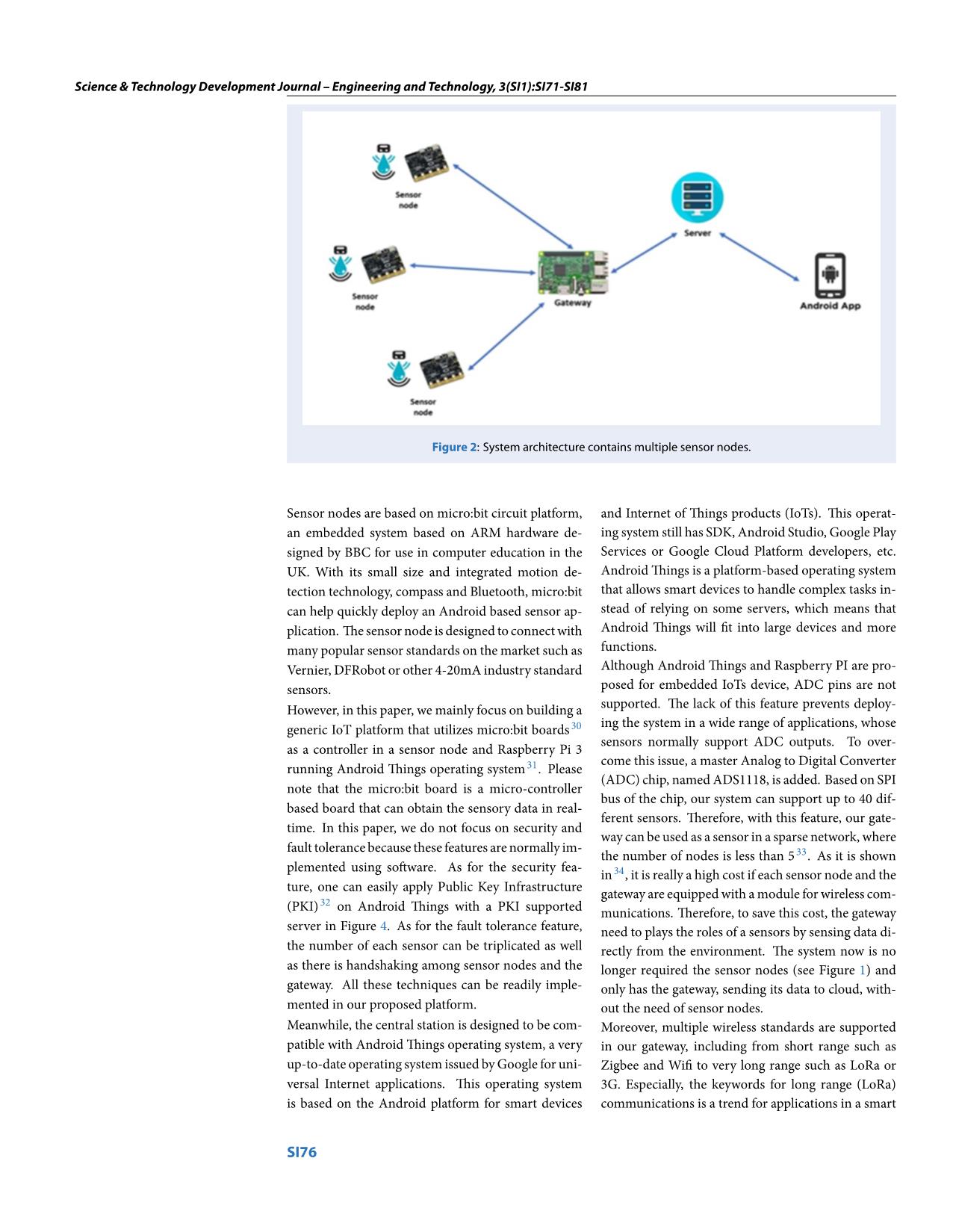
Trang 6
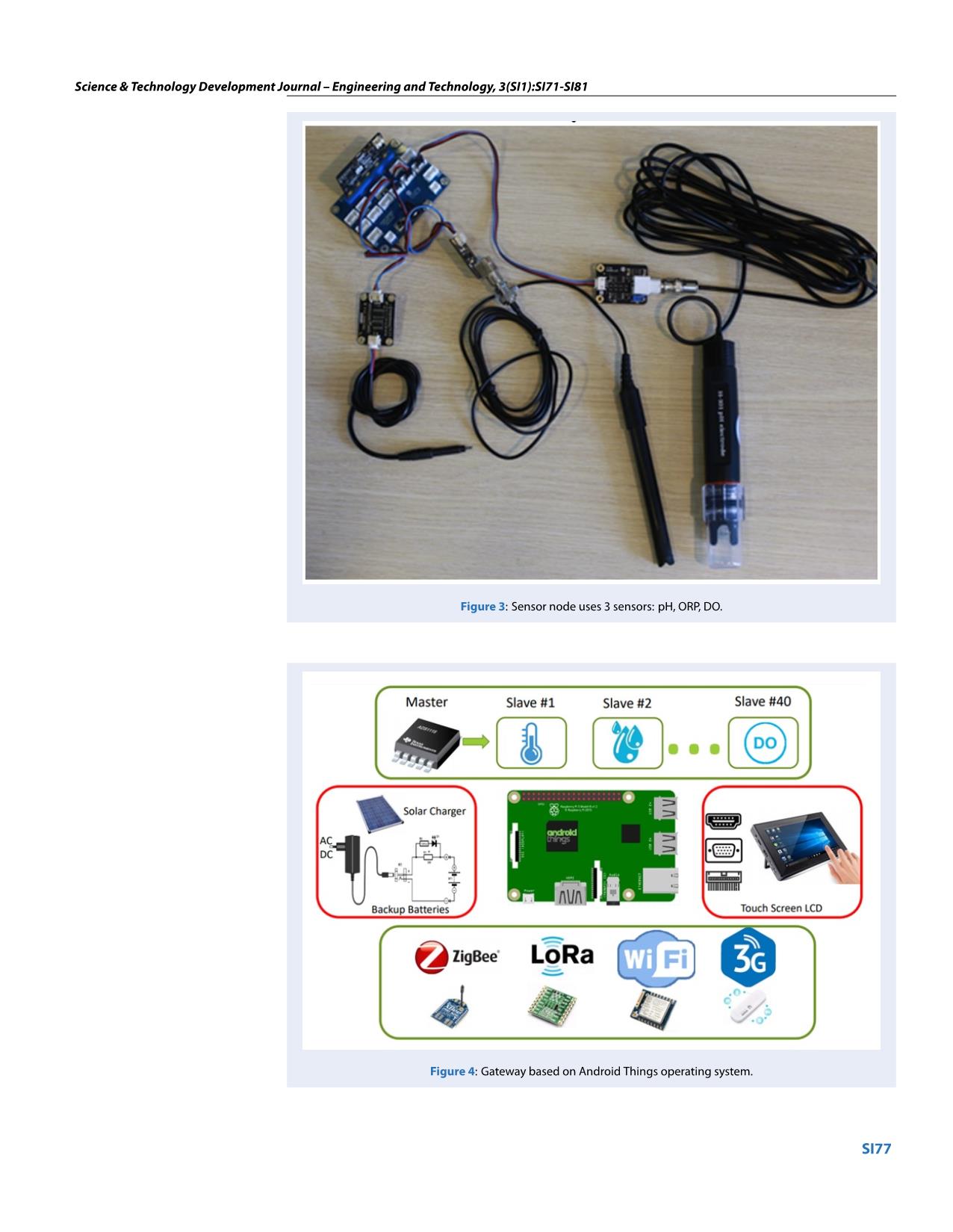
Trang 7
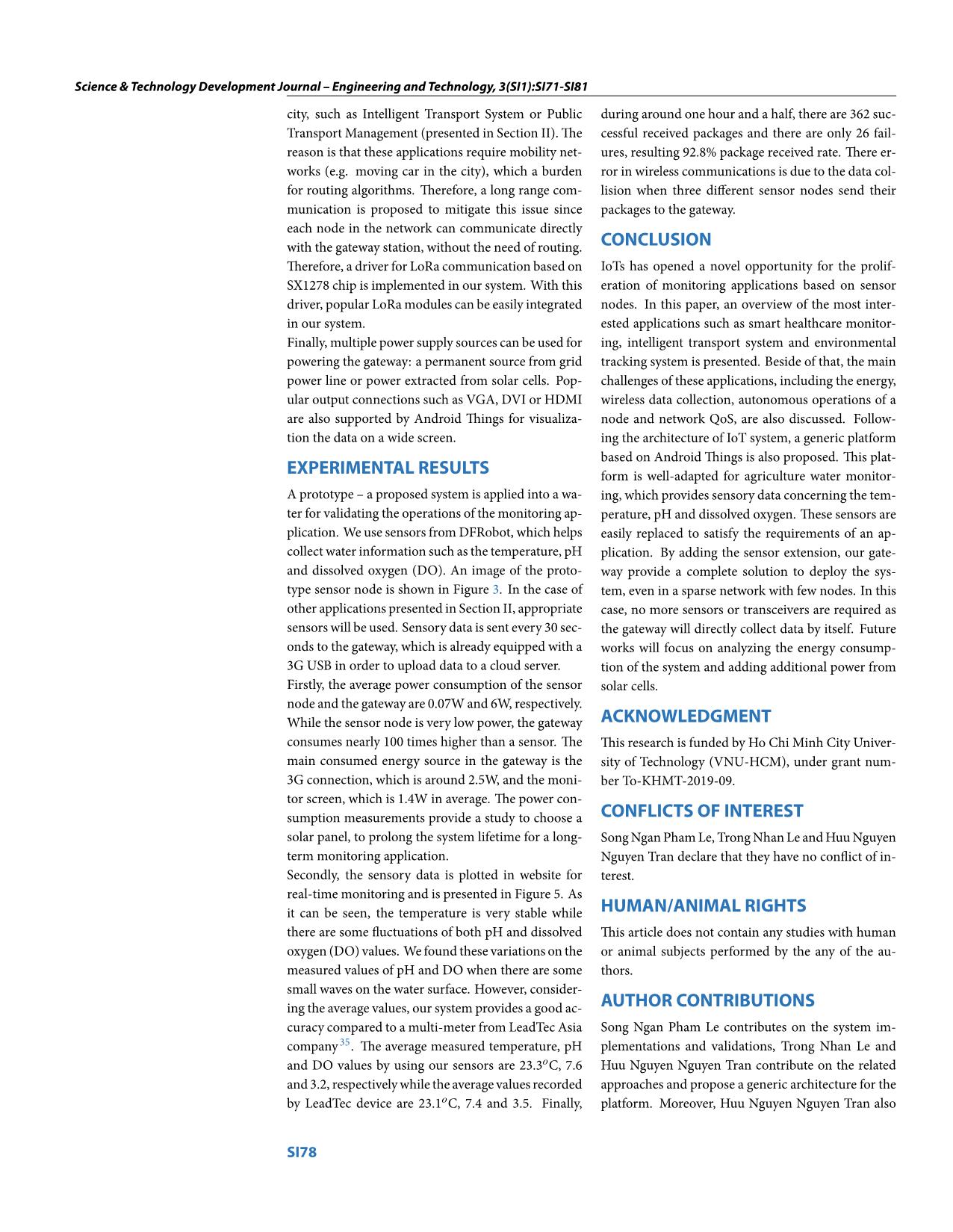
Trang 8

Trang 9
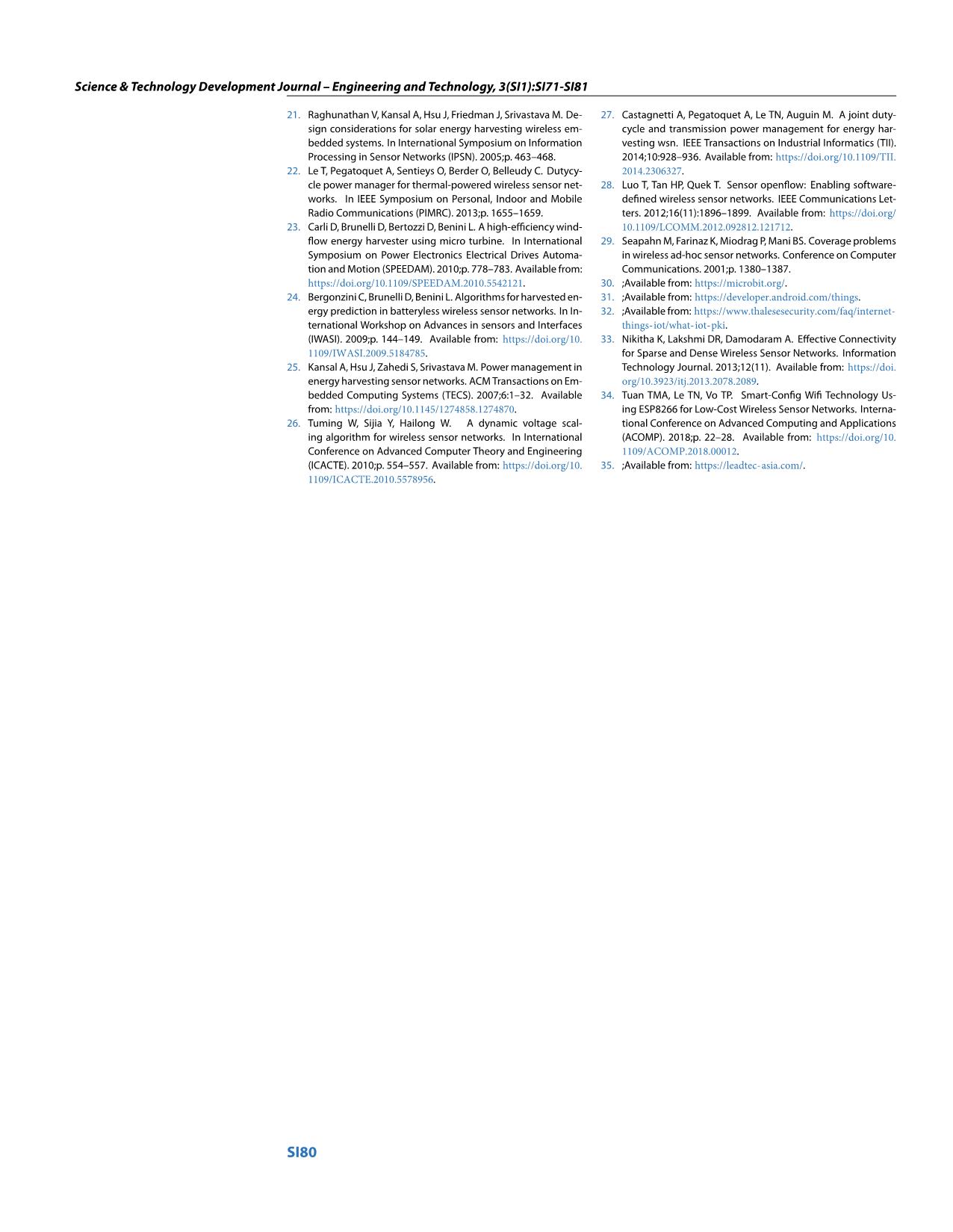
Trang 10
Tải về để xem bản đầy đủ
Tóm tắt nội dung tài liệu: Generic framework for industrial 4.0 applications based on internet of things
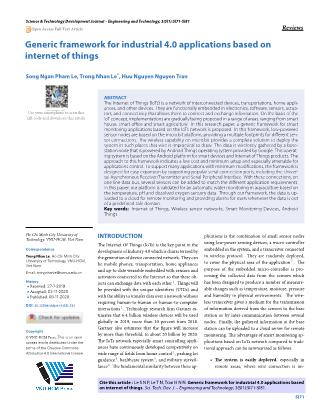
ources can be used for ing, intelligent transport system and environmental powering the gateway: a permanent source from grid tracking system is presented. Beside of that, the main power line or power extracted from solar cells. Pop- challenges of these applications, including the energy, ular output connections such as VGA, DVI or HDMI wireless data collection, autonomous operations of a are also supported by Android Things for visualiza- node and network QoS, are also discussed. Follow- tion the data on a wide screen. ing the architecture of IoT system, a generic platform based on Android Things is also proposed. This plat- EXPERIMENTAL RESULTS form is well-adapted for agriculture water monitor- A prototype – a proposed system is applied into a wa- ing, which provides sensory data concerning the tem- ter for validating the operations of the monitoring ap- perature, pH and dissolved oxygen. These sensors are plication. We use sensors from DFRobot, which helps easily replaced to satisfy the requirements of an ap- collect water information such as the temperature, pH plication. By adding the sensor extension, our gate- and dissolved oxygen (DO). An image of the proto- way provide a complete solution to deploy the sys- type sensor node is shown in Figure 3. In the case of tem, even in a sparse network with few nodes. In this other applications presented in Section II, appropriate case, no more sensors or transceivers are required as sensors will be used. Sensory data is sent every 30 sec- the gateway will directly collect data by itself. Future onds to the gateway, which is already equipped with a works will focus on analyzing the energy consump- 3G USB in order to upload data to a cloud server. tion of the system and adding additional power from Firstly, the average power consumption of the sensor solar cells. node and the gateway are 0.07W and 6W,respectively. While the sensor node is very low power, the gateway ACKNOWLEDGMENT consumes nearly 100 times higher than a sensor. The This research is funded by Ho Chi Minh City Univer- main consumed energy source in the gateway is the sity of Technology (VNU-HCM), under grant num- 3G connection, which is around 2.5W, and the moni- ber To-KHMT-2019-09. tor screen, which is 1.4W in average. The power con- sumption measurements provide a study to choose a CONFLICTS OF INTEREST solar panel, to prolong the system lifetime for a long- Song Ngan Pham Le, Trong Nhan Le and Huu Nguyen term monitoring application. Nguyen Tran declare that they have no conflict of in- Secondly, the sensory data is plotted in website for terest. real-time monitoring and is presented in Figure 5. As it can be seen, the temperature is very stable while HUMAN/ANIMAL RIGHTS there are some fluctuations of both pH and dissolved This article does not contain any studies with human oxygen (DO) values. Wefound these variations on the or animal subjects performed by the any of the au- measured values of pH and DO when there are some thors. small waves on the water surface. However, consider- ing the average values, our system provides a good ac- AUTHOR CONTRIBUTIONS curacy compared to a multi-meter from LeadTec Asia Song Ngan Pham Le contributes on the system im- company 35. The average measured temperature, pH plementations and validations, Trong Nhan Le and and DO values by using our sensors are 23.3oC, 7.6 Huu Nguyen Nguyen Tran contribute on the related and 3.2, respectively while the average values recorded approaches and propose a generic architecture for the by LeadTec device are 23.1oC, 7.4 and 3.5. Finally, platform. Moreover, Huu Nguyen Nguyen Tran also SI78 Science & Technology Development Journal – Engineering and Technology, 3(SI1):SI71-SI81 Figure 5: Sensory data plotted on the visualization screen, including the temperature, pH and DO contributes on the paper writing and checking typos. 7. Puccinelli D, Haenggi M. Wireless sensor networks: applica- tions and challenges of ubiquitous sensing. IEEE Circuits and Systems Magazine. 2005;5(3):19–31. Available from: https: //doi.org/10.1109/MCAS.2005.1507522. ABBREVIATION 8. Deif DS, Gadallah Y. Classification of wireless sensor networks UIDs Unique identifiers deployment techniques. IEEE Communications Surveys Tuto- rials. 2014;16(2):834–855. Available from: https://doi.org/10. MEMS Micro-electro-mechanical systems 1109/SURV.2013.091213.00018. QoS Quality of Service 9. Pasha MA, Derrien S, Sentiey O. Toward ultra low-power hard- WSNs Wireless Sensor Networks ware specialization of a wireless sensor network node. Inter- national Multitopic Conference (INMIC). 2009;p. 1–6. Available MCU Microcontroller Unit from: https://doi.org/10.1109/INMIC.2009.5383135. pH Potential of Hydrogen 10. Fang W, et al. PredictionBased Event Determination in Un- WiFi Wireless Fidelity derwater Wireless Sensor Networks. Conference on Identifi- cation, Information and Knowledge in the Internet of Things ITS Intelligent Transport System (IIKI). 2016;p. 370–373. Available from: https://doi.org/10. ETC Electronic Toll Collection 1109/IIKI.2016.86. PM Particulate Matter 11. Kgotlaetsile M, Mathews. Software defined wireless sen- sor networks application opportunities for efficient network VOC Volatile Organic Compounds management: A survey. Computers Electrical Engineering. ENO Energy Neutral Operation 2018;66:274–287. Available from: https://doi.org/10.1016/j. SDWSN Software Defined Wireless Sensor Network compeleceng.2017.02.026. 12. Xu LD, et al. Internet of Things in Industries: A Survey. IEEE HCMUT Ho Chi Minh city University of Technology Transactions on Industrial Informatics. 2014;10(4):2233–2243. MQTT Message Queuing Telemetry Transport Available from: https://doi.org/10.1109/TII.2014.2300753. PKI Public Key Infrastructure 13. Heeta Y, Wonji L, Hwansoo L. IoT smart home adoption: the importance of proper level automation. Hindawi Journal SDK Software Development Kit of Sensors. 2018;Available from: https://doi.org/10.1155/2018/ ADC Analog Digital Converter 6464036. VGA Video Graphics Array 14. Biljana S, Trivodaliev LR, Kire V. A review of Internet of Things for smart home: Challenges and solutions. Elsevier Journal DVI Digital Visual Interface of Cleaner Production. 2017;140:1454–1464. Available from: HDMI High-Definition Multimedia Interface https://doi.org/10.1016/j.jclepro.2016.10.006. DO Dissolved Oxygen 15. Ray PP. A survey on Internet of Things architectures. Jour- nal of King Saud University - Computer and Information Sci- REFERENCES ences. 2018;30:291–319. Available from: https://doi.org/10. 1016/j.jksuci.2016.10.003. 1. Atzori L, Iera A, Morabito G. The internet of things: A survey. 16. Lin Y, et al. Intelligent Transportation System (ITS): Concept, Computer Networks. 2010;54(15):2787–2805. Available from: Challenge and Opportunity. 2017 IEEE 3rd International Con- https://doi.org/10.1016/j.comnet.2010.05.010. ference on Big Data Security on Cloud. 2017;p. 167–192. 2. Kim T, Kim IH, Sun Y, Jin Z. Physical layer and medium 17. Biswas SP, et al. Intelligent Traffic Monitoring System. access control design in energy efficient sensor networks: Proceedings of the Second International Conference on An overview. IEEE Transactions on Industrial Informatics. Computer and Communication Technologies IC3T 2015. 2015;11(1):2–15. Available from: https://doi.org/10.1109/TII. 2015;2:535–545. Available from: https://doi.org/10.1007/978- 2014.2379511. 81-322-2523-2_52. 3. Chou PH, Park C. Energy-efficient platform designs for real- 18. United States Environmental Protection Agency. Next Gener- world wireless sensing applications. International Conference ation Air Measuring Research, viewed July 12th, 2015;Avail- on CoputerAided Design (ICCAD). 2005;p. 913–920. able from: 4. Idris MYI, et al. Parking guidance system utilizing wireless sen- air-measuringresearchr/. sor network and ultrasonic sensor. Journal on Information 19. Demirkol I, Ersoy C, Onur E. Wake-up receivers for wireless Technology. 2009;8:138–146. Available from: https://doi.org/ sensor networks: benefits and challenges. IEEE Wireless Com- 10.3923/itj.2009.138.146. munications. 2009;16:88–96. Available from: https://doi.org/ 5. Rincon FJ, Paselli M, et al. Os-based sensor node platform and 10.1109/MWC.2009.5281260. energy estimation model for health-care wireless sensor net- 20. Bachir A, Dohler M, Watteyne T, Leung K. Mac essentials for works. Design, Automation and Test in Europe (DATE). 2008;p. wireless sensor networks. IEEE Communications Surveys Tu- 1027–1032. Available from: https://doi.org/10.1145/1403375. torials. 2010;12:222–248. Available from: https://doi.org/10. 1403622. 1109/SURV.2010.020510.00058. 6. He T, Krishnamurthy S, et al. An integrated sensor network system for energyefficient surveillance. ACM Transactions on Sensor Network. 2006;2:1–38. Available from: https://doi.org/ 10.1145/1138127.1138128. SI79 Science & Technology Development Journal – Engineering and Technology, 3(SI1):SI71-SI81 21. Raghunathan V, Kansal A, Hsu J, Friedman J, Srivastava M. De- 27. Castagnetti A, Pegatoquet A, Le TN, Auguin M. A joint duty- sign considerations for solar energy harvesting wireless em- cycle and transmission power management for energy har- bedded systems. In International Symposium on Information vesting wsn. IEEE Transactions on Industrial Informatics (TII). Processing in Sensor Networks (IPSN). 2005;p. 463–468. 2014;10:928–936. Available from: https://doi.org/10.1109/TII. 22. Le T, Pegatoquet A, Sentieys O, Berder O, Belleudy C. Dutycy- 2014.2306327. cle power manager for thermal-powered wireless sensor net- 28. Luo T, Tan HP, Quek T. Sensor openflow: Enabling software- works. In IEEE Symposium on Personal, Indoor and Mobile defined wireless sensor networks. IEEE Communications Let- Radio Communications (PIMRC). 2013;p. 1655–1659. ters. 2012;16(11):1896–1899. Available from: https://doi.org/ 23. Carli D, Brunelli D, Bertozzi D, Benini L. A high-efficiency wind- 10.1109/LCOMM.2012.092812.121712. flow energy harvester using micro turbine. In International 29. Seapahn M, Farinaz K, Miodrag P,Mani BS. Coverage problems Symposium on Power Electronics Electrical Drives Automa- in wireless ad-hoc sensor networks. Conference on Computer tion and Motion (SPEEDAM). 2010;p. 778–783. Available from: Communications. 2001;p. 1380–1387. https://doi.org/10.1109/SPEEDAM.2010.5542121. 30. ;Available from: https://microbit.org/. 24. Bergonzini C, Brunelli D, Benini L. Algorithms for harvested en- 31. ;Available from: https://developer.android.com/things. ergy prediction in batteryless wireless sensor networks. In In- 32. ;Available from: https://www.thalesesecurity.com/faq/internet- ternational Workshop on Advances in sensors and Interfaces things-iot/what-iot-pki. (IWASI). 2009;p. 144–149. Available from: https://doi.org/10. 33. Nikitha K, Lakshmi DR, Damodaram A. Effective Connectivity 1109/IWASI.2009.5184785. for Sparse and Dense Wireless Sensor Networks. Information 25. Kansal A, Hsu J, Zahedi S, Srivastava M. Power management in Technology Journal. 2013;12(11). Available from: https://doi. energy harvesting sensor networks. ACM Transactions on Em- org/10.3923/itj.2013.2078.2089. bedded Computing Systems (TECS). 2007;6:1–32. Available 34. Tuan TMA, Le TN, Vo TP. Smart-Config Wifi Technology Us- from: https://doi.org/10.1145/1274858.1274870. ing ESP8266 for Low-Cost Wireless Sensor Networks. Interna- 26. Tuming W, Sijia Y, Hailong W. A dynamic voltage scal- tional Conference on Advanced Computing and Applications ing algorithm for wireless sensor networks. In International (ACOMP). 2018;p. 22–28. Available from: https://doi.org/10. Conference on Advanced Computer Theory and Engineering 1109/ACOMP.2018.00012. (ICACTE). 2010;p. 554–557. Available from: https://doi.org/10. 35. ;Available from: https://leadtec-asia.com/. 1109/ICACTE.2010.5578956. SI80 Tạp chí Phát triển Khoa học và Công nghệ – Kĩ thuật và Công nghệ, 3(SI1):SI71-SI81 Open Access Full Text Article Bài Tổng quan Nền tảng tổng quát cho các ứng dụng giám sát thông minh dựa trên Internet vạn vật Phạm Lê Song Ngân, Lê Trọng Nhân*, Nguyễn Trần Hữu Nguyên TÓM TẮT Internet of Things (IoTs) là mạng của các thiết bị vật lý, phương tiện, thiết bị gia dụng và các mặt hàng khác được nhúng với thiết bị điện tử, phần mềm, cảm biến, thiết bị truyền động và kết nối Use your smartphone to scan this cho phép những thứ này kết nối và trao đổi dữ liệu. Dựa trên khái niệm về IoT, các ứng dụng ngày QR code and download this article càng được đề xuất trong nhiều lĩnh vực khác nhau, từ nhà thông minh, văn phòng thông minh đến nông nghiệp thông minh. Trong bài báo này, một nền tảng tổng quát cho các ứng dụng giám sát thông minh dựa trên mạng IoT được đề xuất. Trong nền tảng này, các nốt cảm biến năng lượng thấp được dựa trên nền tảng bo mạch micro:bit, có khả năng cung cấp nhiều kết nối với các cảm biến khác nhau. Khả năng giao tiếp không dây cung cấp một giải pháp hoàn chỉnh để triển khai hệ thống ở những nơi mà việc đi dây là không khả thi. Dữ liệu được thu thập không dây bởi một nốt trạm chủ, được cài đặt hệ điều hành Android Things do Google cung cấp. Cách tiếp cận của chúng tôi cung cấp một giải pháp triển khai với chi phí thấp với thiết lập tối thiểu, và đặc biệt có thể mở rộng được cho các ứng dụng giám sát. Để có thể hỗ trợ nhiều loại ứng dụng khác nhau với việc thay đổi là ít nhất, hệ thống của chúng tôi đễ dàng mở rộng với các cổng kết nối nối tiếp, như là cổng Truyền/Nhận bất đồng bộ thông dụng và cổng giao tiếp nối tiếp SPI. Với những cổng giao tiếp này, chỉ với một đường dữ liệu, nhiều loại cảm biến có thể được kết nối vào hệ thống. Trong bài báo này, hệ thống của chúng tôi được ứng dụng để theo dõi nước tự động trong nuôi trồng thủy sản dựa trên dữ liệu cảm biến oxy hòa tan, pH và nhiệt độ. Dữ liệu được tải lên điện toán đám mây cho việc giám sát từ xa và cung cấp những cảnh báo khi giá trị của cảm biến vượt ngưỡng an toàn. Từ khoá: Internet vạn vật, Mạng cảm biến không dây, Thiết bị giám sát thông minh, Android Things Trường Đại học Bách Khoa, ĐHQG-HCM, Việt Nam Liên hệ Lê Trọng Nhân, Trường Đại học Bách Khoa, ĐHQG-HCM, Việt Nam Email: trongnhanle@hcmut.edu.vn Lịch sử • Ngày nhận: 27-7-2019 • Ngày chấp nhận: 03-11-2020 • Ngày đăng: 09-11-2020 DOI :10.32508/stdjet.v3iSI1.513 Bản quyền © ĐHQG Tp.HCM. Đây là bài báo công bố mở được phát hành theo các điều khoản của the Creative Commons Attribution 4.0 International license. Trích dẫn bài báo này: Ngân P L S, Nhân L T, Nguyên N T H. Nền tảng tổng quát cho các ứng dụng giám sát thông minh dựa trên Internet vạn vật. Sci. Tech. Dev. J. - Eng. Tech.; 3(SI1):SI71-SI81. SI81
File đính kèm:
 generic_framework_for_industrial_4_0_applications_based_on_i.pdf
generic_framework_for_industrial_4_0_applications_based_on_i.pdf

